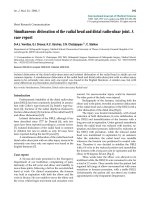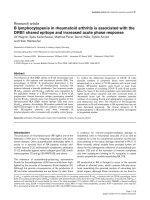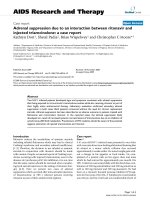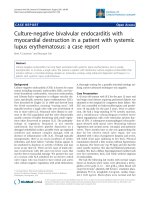Báo cáo y học: "Successful pregnancy in pulmonary arterial hypertension associated with systemic lupus erythematosus: a case report" doc
Bạn đang xem bản rút gọn của tài liệu. Xem và tải ngay bản đầy đủ của tài liệu tại đây (164.35 KB, 4 trang )
Case report
Open Access
Successful pregnancy in pulmonary arterial hypertension associated
with systemic lupus erythematosus: a case report
Michael Streit, Rudolf Speich, Manuel Fischler and Silvia Ulrich*
Address: Department of Internal Medicine, University Hospital of Zurich, Raemistrasse 100, 8091 Zurich, Switzerland
Email: MS - ; RS - ; MF - ; SU* -
* Corresponding author
Received: 19 August 2008 Accepted: 23 January 2009 Published: 9 June 2009
Journal of Medical Case Reports 2009, 3:7255 doi: 10.4076/1752-1947-3-7255
This article is available from: />© 2009 Streit et al; licensee Cases Network Ltd.
This is an Open Access article distributed under the terms of the Creative Commons Attribution License (
/>which permits unrestricted use, distribution, and reproduction in any medium, provided the original work is properly cited.
Abstract
Introduction: Pulmonary arterial hypertension is a complication of systemic lupus erythematosus.
Mortality in pregnant patients with pulmonary arterial hypertension related to connective tissue
disease is as high as 56%. The authors report the first case of a successful maternal-fetal outcome in a
pregnant patient with systemic lupus erythematosus-associated pulmonary arterial hypertension
treated with sildenafil and inhaled iloprost during pregnancy and until several weeks after caesarean
section.
Case presentation: The case presented is of a 29-year-ol d woman with systemic lupus
erythematosus and associated severe pulmonary arterial hypertension. Vasodilator therapy with
bosentan and sildenafil, immunosuppressive therapy with prednisone, hydroxychloroquine and
azathioprine and oral anticoagulation (phenprocoumon) had normalized her right ventricular over
right atrial pressure when she was diagnosed in her 5th week of pregnancy. The teratogenic drugs
bosentan and phenprocoumon were stopped, the latter replaced by low molecular weight heparin.
During the 35th week, a slight increase in pulmonary pressure was found. Therapy with inhaled
iloprost was established. A caesarean section was performed in the 37th week and a healthy baby was
delivered. The patient remained stable until 11 weeks after delivery, when an increase in right
ventricular over right atrial pressure was noted. Bosentan was reintroduced and prednisone and
azathioprine doses were increased. The patient has remained stable until the present time.
Conclusion: Pulmonary arterial hypertension has been considered a contraindication for pregnancy.
Novel vasodilator therapy, combined with immunosuppressants in this patient with systemic lupus
erythematosus, may ‘cure’ pulmonary arterial hypertension and permit pregnancy with successful
outcome. However, postpartum exacerbation of systemic lupus erythematosus and pulmonary
arterial hypertension have to be considered.
Page 1 of 4
(page number not for citation purposes)
Introduction
Systemic lupus erythematosus (SLE) occurs most often in
the reproductive years of female patients [1]. The
percentage of pulmonary arterial hypertension (PAH) in
SLE has been reported to range from 0.5% to 14% [2].
PAH is aggravated by physiological changes associated
with pregnancy [3]. Mortality in pregnant patients with
PAH related to connective tissue disease is as high as 56%
[4]. Typically, patients die after delivery due to acute right
ventricular failure [4]. Herein we report the first case of a
successful maternal-fetal outcome in a pregnant patient
with SLE-associated PAH treated with sildenafil and
inhaled iloprost during pregnancy and until several
weeks after caesarean section.
Case presentation
A 29-year-old woman had been diagnosed with SLE
according to the American College of Rheumatology
criteria 6 years earlier due to malar rash, photosensitivity,
arthritis of the finger joints, wrists and knees, pleural
effusion and abnormal titers of the antinuclear and
antinative DNA antibodies. Treatment consisted of pre-
dnisone as needed and hydroxychloroquine (200 mg/
day). Five years after the initial diagnosis, the patient
developed exertional dyspnea. Severe PAH was diagnosed
by echocardiography and confirmed by pulmonary arterial
catheterization (PAC) (Table 1).
Oral anticoagulation with phenprocoumon and treatment
with bosentan (125 mg bid) and sildenafil (50 mg tid) was
initiated. Cyclophosphamide (100 mg qd) was added to
the SLE therapy for 4 months and thereafter replaced by
azathioprine (100 mg qd). The patient’s clinical status
improved significantly and repeated PAC 3 months later
showed a significant decrease in mean pulmonary arterial
pressure (MPAP) with a concomitant increase in cardiac
index (CI) resulting in a decreased pulmonary vascular
resistance (PVR) (Table 1). Echocardiography performed
after a further 8 months under a stable clinical condition
showed completely normalized right heart dimensions
and pulmonary arterial pressure. One week later, preg-
nancy at the 5th week of gestation was diagnosed, despite
repeated advice to practice birth control and insistent
information about the maternal and fetal risks of
pregnancy in SLE-associated PAH as well as the teratogenic
potential of bosentan and phenpr ocoumon. Since a
termination of the pregnancy was out of the question for
the patient, bosentan and phenprocoumon were immedi-
ately stopped and low molecular weight heparin (LMWH)
was started. Sildenafil, azathioprine, and hydroxychlor-
oquine were left unchanged whereas prednisone was
augmented to 25 mg daily to prevent SLE relapse. The
patient was followed fortnightly by an interdisciplinary
team and repeated clinical and echocardiographic exam-
inations remained stable until the 35th week of gestation.
Intrauterine fetal growth assessed sonographically was
normal at all times.
At 35 weeks however, echocardiography showed an
elevated right ventricular systolic pressure (RVSP) of
40 mmHg above the right atrial pressure. The patient was
hospitalized and treatment with inhaled iloprost was
established 5 to 6 times daily at an initial daily dose of
50 mg, increasing to 100 mg within 1 week. A caesarean
section was scheduled for week 37. Hemodynamic assess-
ment with PAC before the operation showed a MPAP
between 20 and 26 mmHg with a CI around 4-5 L/min/m
2
.
A healthy female infant weighing 2760 g with Apgar scores
of 8, 9 and 10 at 1, 5 and 10 minutes, respectively, was
delivered via caesarean section under epidural anesthesia.
The patient remained stable throughout the operation. The
PAC was continued during 24 hours postoperatively
showing stable pulmonary hemodynamics. Prednisone
was augmented to 50 mg qd on the day of delivery and
then continued at a dose of 30 mg qd for the next 2 months
to prevent postpartal relapse of SLE. Mother and child were
discharged 10 days later under stable conditions. Breast-
feeding was declined. Sildenafil, inhaled iloprost,
azathioprine and hydroxychloroquine were continued,
LMWH was replaced by phenprocoumon. Eleven weeks
later, progressive dyspnea and fatigue developed and a
relapse of SLE was diagnosed with reappearance of tender
swollen joints in the fingers, wrists and knees, malar rash
and pleuropericardial effusion. Echocardiography showed a
rise in RVSP to 57 mmHg. Prednisone and azathioprine
were augmented to 50 mg qd and 150 mg qd, respectively,
and bosentan 125 mg bid was added to the established
therapy. The patient remains in a stable condition and her
daughter is thriving well.
Discussion
This case demonstrates for the first time cure of SLE-
associated PAH and successful pregnancy with combina-
tion immunosuppressive and vasodilator therapy.
In healthy women, physiological changes associated with
pregnancy and puerperium pose a great challenge on the
cardiovascular system. During this period, the CI increases
by 30% to 50%, the blood volume by 50%, and oxygen
consumption by 20% [4]. This significant increase in
pulmonary blood flow is maintained at an unchanged
MPAP resulting in a decreased PVR [5]. Immediately after
delivery an autotransfusion of approximately 500 ml of
blood from the involuting uterus occurs, leading to a
further increase in maternal blood volume [3]. Patients with
PAH have a limited ability to compensate for this increase
in CI and blood volume due to their fixed resistance of the
pulmonary vasculature. This may lead to acute or chronic
right heart failure with the highest incidence of maternal
mortality occurring during the first days after delivery [4].
Page 2 of 4
(page number not for citation purposes)
Journal of Medical Case Reports 2009, 3:7255 />No agreement exists concerning the influence of pregnancy
on the course of SLE. The reported incidence of SLE flares
during pregnancy ranges from 13% to 60%, leading some
investigators to believe the flare rate is unchanged while
others consider pregnancy as a time of vulnerability to
increased disease activity [6,7]. Patients with inactive SLE at
conception are less likely to experience flares during
pregnancy [6]. Our patient had normalized her pulmonary
artery pressure assessed by echocardiography just before
pregnancy under intensive therapy. To what extent this was
a prerequisite for the uneventful pregnancy remains
unknown. From pathophysiological and clinical experi-
ence, it must be assumed that the pregnancy-related
mortality will increase with the degree of PAH.
Patients with SLE-related antiphospholipid syndrome are
at increased risk for spontaneous miscarriage. Antipho-
spholipid antibodies were not found in our patient.
Another threat to fetal outcome in SLE patients is neonatal
lupus, a transferred autoimmune syndrome occurring in
babies born to mothers with anti-Ro antibodies, which may
lead to complete heart block and isolated skin rash. Our
patient did have anti-Ro antibodies, fortunately however,
no signs of intrauterine or postpartal heart block were
detected by repeated pulsed duplex echocardiography and
no skin manifestations were present after delivery.
Medical therapy of patients with PAH has improved
considerably in recent years. Available drugs focus on the
main dysfunctional pathways known to date and include
anticoagulation therapy, prostaglandin analogues for
example, epoprostenol, iloprost, treprostinil; endothelin-
1 receptor antagonists for example, bosentan; and
phosphodiesterase 5 inhibitors for example, sildenafil.
With respect to pregnancy, bosentan is contraindicated
due to its teratogenic potential [8]. Anticoagulation
therapy is generally recommended in PAH. As our patient
improved considerably on anticoagulation, immunosup-
pressive therapy and newer vasodilator and antiprolifera-
tive agents and we did not know to what extent which of
the measures was responsible for the amelioration of the
patient, we decided to maintain the therapy as far as
possible. We replaced the potentially teratogenic phen-
procoumon with low molecular weight heparin but
stopped bosentan. Recently, several reports of successful
maternal and fetal outcome with intravenous and inhaled
iloprost treatment at different stages of pregnancy and
postpartum period have been published [9,10]. None-
theless, cases of maternal deaths are still not unusual [9].
To the best of our knowledge, the use of sildenafil during
pregnancy in patients with PAH has only been described in
two patients with Eisenmenger’s syndrome. One of them
was a 22-year-old patient treated with sildenafil 150 mg/
day during gestational weeks seven and eight. Sildenafil
was discontinued thereafter for financial reasons but
restarted at gestational week 31 after an acute exacerbation
of PAH with a good outcome of mother and infant [11].
The second case reports a 23-year-old patient treated with
bosentan in whom pregnancy was not diagnosed before
Table 1. Summary of recorded physiology
Pregnancy
Diagnosis PAH 3 months later 5
th
week 20
th
week 35
th
week Delivery 3 months
postpartum
NYHA IV III III III III III IV
6-MWT m 229 423 454 396 276 392
RVSP mmHg (Echo) 69 normal normal 40 57
SPAP mmHg 72 57 45
MPAP mmHg 52 35 21
PAOP mmHg 10 8 7
CI L/min/m
2
1.3 3.4 4.3
PVR dyn.sec.cm
−5
1580 410 250
mVO
2
%3567 69
SLEDAI [14] 17 2 2 14 18
Phenprocoumon (INR) 2.1 2.2 2.1
LMWH (Dalteparin E/day) 10,000 10,000
Prednisone (mg/day) 50 30 10 25 25 50 50
Hydroxychloroquine (mg/day) 200 200 200 200 200 200 200
Cyclophosphamide (mg/day) 100 100
Azathioprine (mg/day) 100 100 100 100 150
Bosentan (mg/day) 250 250 250
Sildenafil (mg/day) 150 150 150 150 150 150 150
Inhaled iloprost (mg/day) 50 100
NYHA, New York Heart Association; 6-MWT, 6 minute walking test distance; RVSP, echocardiographic systolic right ventricular pressure over right atrial
pressure; hemodynamic assessments by right heart catheterization: SPAP, systolic pulmonary arterial pressure; MPAP, mean pulmonary arterial pressure;
PAOP, pulmonary arterial occlusive pressure; CI, cardiac index; PVR, pulmonary vascular resistance; mVO
2
, mixed venous oxygen saturation; SLEDAI,
systemic lupus erythematosus disease activity index; LMWH, low molecular weight heparin.
Page 3 of 4
(page number not for citation purposes)
Journal of Medical Case Reports 2009, 3:7255 />28 weeks of gestation. Sildenafil was added, and both
drugs were continued until the premature termination of
pregnancy via a caesarean section at week 30 because of
maternal cardiopulmonary deterioration and decreased
fetal movements. The delivered baby girl was healthy and
without signs of bosentan teratogenicity [12].
Our patient with PAH not related to Eisenmenger’s
syndrome is the first treated with sildenafil during the
entire pregnancy. Until today, nothing was known about
the possible teratogenic effects of sildenafil. It inhibits
phosphodiesterase type 5, an enzyme that metabolizes
cyclic guanosine monophosphate (cGMP) thereby enhan-
cing the cGMP mediated relaxation and growth inhibition
of smooth muscle in the lung vasculature [13]. Vasodila-
tive therapy with oral sildenafil controlled our patient’s
PAH well until gestational week 35. The relatively mild
deterioration thereafter was successfully treated by adding
inhaled iloprost. Sildenafil might have additional bene-
ficial effects with respect to fetal growth retardation (FGR)
in the context of pregnancies at risk, as this is well known
in patients with PAH and SLE [14]. FGR is typically related
to placental insufficiency due to reduced blood flow and
increased resistance in the uterine arteries. In vitro, the
incubation of sildenafil with small myometrial arteries
from women with a history of FGR showed a decreased
response to vasoconstrictors. This might suggest a poten-
tial beneficial effect of sildenafil on uteroplacental blood
flow in vivo as well [15].
Conclusion
This case strengthens our hypothesis and might place
sildenafil as first line therapy for PAH in pregnancy. The
combination of sildenafil with prostaglandin analogues
for the management of disease exacerbations in SLE
broadens the therapeutic armamentarium with potentially
less side effects than the prolonged single use of
prostaglandin analogues. However, sildenafil’s true ther-
apeutic potential during pregnancy awaits further clinical
evaluation, and it has to be stressed that, despite most
modern treatment options, the mortality rate of pregnancy
in PAH remains high.
Abbreviations
cGM P, cyclic guanosine monophosphate; CI, cardiac
index; FGR, fetal growth retardation; LMWH, low mole-
cular weight heparin; MPAP, mean pulmonary arterial
pressure; PAC, pulmonary arterial catheterization; PAH,
pulmonary arterial hypertension; PVR, pulmonary vascu-
lar resistance; RVSP, right ventricular systolic pressure over
right atrial pressure; SLE, systemic lupus erythematosus.
Consent
Written informed consent was obtained from the patient
for publication of this case report. A copy of the written
consent is available for review by the Editor-in-Chief of
this journal.
Competing interests
The authors declare that they have no competing interests.
Authors’ contributions
MS searched the literature and drafted the manuscript. MS,
RS, MF and SU managed the clinical case of the patient. RS,
MF and SU edited the manuscript. The final manuscript
has been seen and approved by all the authors.
References
1. McMillan E, Martin WL, Waugh J, Rushton I, Lewis M, Clutton-
Brock T, Townend JN, Kilby MD, Gordon C: Management of
pregnancy in women with pulmonary hypertension second-
ary to SLE and anti-phospholipid syndrome. Lupus 2002,
11:392-398.
2. Tanaka E, Harigai M, Tanaka M, Kawaguchi Y, Hara M, Kamatani N:
Pulmonary hypertension in systemic lupus erythematosus:
evaluation of clinical characteristics and response to immu-
nosuppressive treatment. J Rheumatol 2002, 29:282-287.
3. Budev MM, Arroliga AC, Emery S: Exacerbation of underlying
pulmonary disease in pregnancy. Crit Care Med 2005, 33:
S313-S318.
4. Weiss BM, Hess OM: Pulmonary vascular disease and preg-
nancy: current controversies, management strategies, and
perspectives. Eur Heart J 2000, 21:104-115.
5. Robson SC, Hunter S, Boys RJ, Dunlop W: Serial changes in
pulmonary haemodynamics during human pregnancy: a non-
invasive study using Doppler. Clin Sci 1991, 80:113-117.
6. Urowitz MB, Gladman DD, Farewell VT, Stewart J, McDonald J:
Lupus and pregnancy studies. Arthritis Rheum 1993, 36:1392-1397.
7. Khamashta MA, Ruiz-Irastorza G, Hughes GR: Systemic lupus
erythematosus flares during pregnancy. Rheum Dis Clin North Am
1997, 23:15-30.
8. Cheng JW: Bosentan. Heart Dis 2003, 5:161-169.
9. Easterling TR, Ralph DD, Schmucker BC: Pulmonary hypertension
in pregnancy: treatment with pulmonary vasodilators. Obstet
Gynecol 1999, 93:494-498.
10. Elliot CA, Stewart P, Webster VJ, Mills GH, Howarth ES, Bullock FA,
Lawson RA, Amstrong IJ, Kiely DG: The use of iloprost in early
pregnancy in patients with pulmonary arterial hypertension.
Eur Respir J 2005, 26:168-173.
11. Lacassie HJ, Germain AM, Valdes G, Fernandez MS, Allamand F,
Lopez H: Management of Eisenmenger syndrome in preg-
nancy with silden afil and L-arginine. Obstet Gynecol 2004,
103:1118-1120.
12. Molelekwa V, Akhter P, McKenna P, Bowen M, Walsh K: Eisen-
menger’s syndrome in a 27 week pregnancy - management
with bosentan and sildenafil. Ir Med J 2005, 98:87-88.
13. Galie N, Ghofrani HA, Torbicki A, Barst RJ, Rubin LJ, Badesch D,
Fleming T, Parpia T, Burgess G, Branzi A, Grimminger F, Kurzyna M,
Simonneau G: Sildenafil citrate therapy for pulmonary arterial
hypertension. N Engl J Med 2005, 353:2147-2157.
14. Gladman DD, Ibanez D, Urowitz MB: Systemic Lupus Erythema-
tosus Disease Activity Index 2000. J Rheumatol 2002, 29:288-291.
15. Wareing M, Myers JE, O’Hara M, Baker PN: Sildenafil citrate
(Viagra) enhances vasodilatation in fetal growth restriction.
J Clin Endocrinol Metab 2005, 90:2550-2555.
Page 4 of 4
(page number not for citation purposes)
Journal of Medical Case Reports 2009, 3:7255 />









